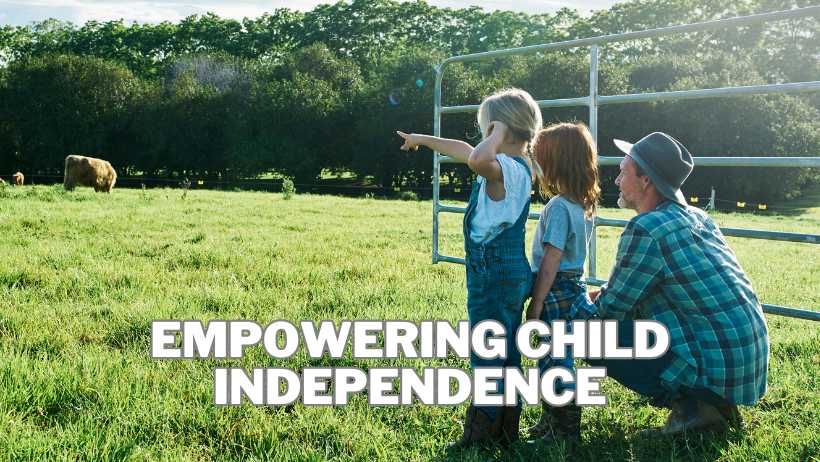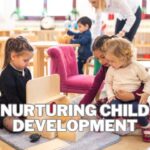
Learn how to strike a balance between granting autonomy and ensuring safety in empowering child independence.
Discover the importance of age-appropriate opportunities that foster growth while protecting well-being. Build trust, teach personal responsibility, and establish boundaries to create a safe space for children to freely express themselves and make informed decisions.
Gradually nurture independence based on maturity, empower children to make informed choices, and overcome parental fear and overprotection. Find the right balance between support and freedom to shape resilient individuals capable of conquering life’s challenges.
Imagine a world where children are confident, self-reliant, and capable of navigating life’s challenges with grace. This is the vision that “The Importance of Balancing Autonomy and Safety in Empowering Child Independence” explores.
In this article, we delve into the crucial role of parents in striking a balance between granting autonomy and ensuring safety for their children. From allowing them to make mistakes and learn from them, to gradually increasing their level of independence as they grow older, this article emphasizes the need for age-appropriate opportunities that foster individual growth while protecting their well-being.
By involving children in establishing household rules, teaching them personal responsibility, and equipping them with the knowledge of potential dangers, parents not only empower their children to thrive independently but also ensure their safety.
Trust-building and open communication act as the foundation for creating a safe space where children can freely express themselves and make informed decisions. With careful consideration of a child’s age, maturity, and capabilities, fostering independence becomes a gradual process that ultimately shapes them into resilient individuals capable of conquering life’s challenges.
Understanding Autonomy and Safety in Child Independence
In order to properly foster child independence, it is important to understand the concepts of autonomy and safety. Autonomy refers to the ability for a child to make their own decisions and take responsibility for their actions.
It allows them to develop a sense of self and build confidence in their abilities. Safety, on the other hand, ensures that children are protected from harm and potential dangers. It is crucial to strike a balance between autonomy and safety, allowing children to explore and develop their independence while also ensuring their well-being.
Defining autonomy and safety in the context of child independence
Autonomy in the context of child independence means allowing children to have a sense of control and decision-making power over their own lives. It involves giving them age-appropriate responsibilities and tasks that promote their growth and development.
Safety, on the other hand, entails creating an environment that is free from harm and potential dangers. It involves setting boundaries and establishing safety measures to protect children from physical and emotional harm. Balancing autonomy and safety ensures that children have the freedom to explore and learn, while also being protected and guided.
Exploring the benefits of fostering independence in children
Fostering independence in children has numerous benefits for their overall growth and development. It allows them to develop essential life skills such as problem-solving, decision-making, and responsibility.
Independence also promotes self-confidence and self-esteem, as children learn to trust in their abilities and make their own choices. It instills a sense of resilience and adaptability, as children learn to navigate challenges and setbacks. Additionally, independence helps children develop a strong sense of identity and individuality, enabling them to pursue their passions and interests.
Recognizing the importance of balancing autonomy and safety
While fostering independence is important, it is equally crucial to balance autonomy with safety. Parents must ensure that children are not exposed to unnecessary risks or dangers. Striking a balance between autonomy and safety involves providing children with age-appropriate opportunities for independence, gradually increasing their level of autonomy as they grow older.
It also entails setting boundaries and establishing safety measures to protect children from potential harm. By finding the right balance, parents can empower their children to explore, grow, and learn, while also ensuring their well-being.
Providing Age-Appropriate Opportunities for Independence
Identifying suitable tasks and responsibilities based on age is vital when providing opportunities for independence. Younger children can be given simple tasks, such as helping with household chores or making their bed.
As they grow older, they can take on more responsibilities, such as managing their schoolwork or participating in extracurricular activities. It is important to match the level of autonomy with their developmental stage to ensure they can handle the tasks effectively.
Gradually increasing autonomy as children grow older allows them to develop and learn at their own pace. It gives them the opportunity to overcome challenges and build confidence in their abilities. For example, allowing teenagers to manage their own finances or make decisions about their education can empower them to take responsibility for their future.
Encouraging exploration and risk-taking within safe boundaries is essential to foster independence. While it is important for children to experience new things and take risks, it should be done within a safe and secure environment. Providing opportunities for children to try new activities or participate in hobbies they are interested in can build their independence while ensuring their safety.
Teaching Personal Responsibility and Establishing Rules
Imparting the concept of personal responsibility to children is crucial in fostering independence. Teaching them to take ownership of their actions and choices helps them understand the consequences of their decisions. By instilling a sense of personal responsibility, children can develop self-discipline, accountability, and a strong work ethic.
Involving children in establishing household rules allows them to feel a sense of ownership and responsibility. Parents can engage children in discussions about rules and expectations, giving them the opportunity to voice their opinions and contribute to the decision-making process. This involvement empowers children to take responsibility for their own behavior, promoting independence and self-regulation.
Promoting accountability and positive decision-making is an important aspect of teaching personal responsibility. Encouraging children to reflect on their actions and make amends when necessary helps them develop a sense of integrity and empathy. By holding children accountable for their choices, parents can guide them towards making positive decisions and taking responsibility for their own actions.
Maintaining Safety Through Boundaries and Safety Measures
Setting appropriate boundaries is essential to ensure the safety of children. Boundaries help children understand their limits and make informed choices within those limits. Parents should establish boundaries that align with their child’s age, maturity, and capabilities.
For example, younger children may have boundaries regarding physical safety, such as not crossing the street without an adult, while older children may have boundaries regarding internet usage or curfew times.
Establishing safety measures and protocols at home and outside is crucial in maintaining the well-being of children. This includes childproofing the house, ensuring the use of safety equipment, and teaching children about potential dangers.
Parents should also educate children on how to respond to emergencies and seek help when needed. By implementing safety measures, parents create a safer environment for children to explore and exercise their independence.
Teaching children about potential dangers and risk management is a key component of maintaining their safety. This involves discussing topics such as stranger danger, fire safety, and internet safety.
Parents should engage in open and honest conversations about potential risks and equip children with the knowledge and skills to navigate challenging situations. By educating children about potential dangers, parents empower them to make informed decisions and take proactive measures to ensure their own safety.
Creating a Safe Space for Open Communication and Trust
Fostering open communication between parents and children is essential in creating a safe space for children to express themselves. Parents should establish a non-judgmental environment where children feel comfortable sharing their thoughts, concerns, and experiences. Active listening and empathy play a crucial role in open communication, as parents validate children’s feelings and provide support.
Encouraging children to express their thoughts and concerns is important in helping them develop their own voice and assertiveness. Parents can create opportunities for children to share their opinions and actively involve them in decision-making processes. This involvement not only enhances children’s independence but also strengthens their communication skills and self-confidence.
Building trust through active listening and empathy is foundational in fostering independence. Parents should be attentive to their child’s needs, fears, and desires, and respond with understanding and compassion. By acknowledging and validating their feelings, parents can nurture a trusting relationship with their children. This trust allows children to feel secure in exploring their independence and making informed decisions.
Gradual Nurturing of Independence Based on Maturity
When nurturing independence in children, it is important to consider their age, maturity, and capabilities. Each child develops at their own pace, and parents should tailor their approach accordingly. While it is important to encourage independence, it should be done in a gradual and age-appropriate manner.
Providing opportunities for decision-making and problem-solving allows children to develop crucial skills for independence. Parents can involve children in decision-making processes, such as planning family outings or managing their own schedules. This involvement fosters critical thinking, self-reliance, and a sense of ownership over their choices.
Supporting children in learning from their mistakes is a valuable aspect of nurturing independence. Making mistakes is a natural part of growth and development. Parents should provide a supportive environment where children can learn from their failures and develop resilience. By embracing failures as learning opportunities, children become more confident in their abilities and are motivated to continue exploring their independence.
Empowering Children to Make Informed Decisions
Teaching critical thinking and decision-making skills is essential in empowering children to make informed choices. Parents can encourage children to think critically and evaluate different options before making decisions. They can ask open-ended questions and engage in discussions that promote independent thinking. This skill not only benefits children in their daily lives but also prepares them for future challenges and decision-making.
Providing information and guidance for informed choices is crucial in empowering children. Parents should share relevant information, such as potential risks and benefits, to help children make well-rounded decisions. By equipping children with knowledge and different perspectives, parents enable them to consider various factors and make informed choices.
Supporting children in understanding consequences and evaluating risks is essential in fostering independence. Parents can discuss the potential outcomes of different decisions and help children evaluate the risks associated with certain choices. By fostering a sense of accountability and responsibility, children become more capable of making independent and thoughtful decisions.
Recognizing and Overcoming Parental Fear and Overprotection
Understanding common fears and concerns of parents is important in facilitating the independence of children. It is natural for parents to worry about their children’s safety and well-being, but excessive fear and overprotection can hinder their development. By acknowledging and addressing these fears, parents can gradually overcome them and support their children’s independence.
Identifying and addressing overprotective behaviors is crucial in promoting child independence. Overprotective parents tend to limit their children’s experiences and opportunities for growth. By recognizing these behaviors and consciously challenging them, parents can create a more nurturing and empowering environment that allows children to develop their independence.
Seeking support and guidance to overcome parental anxieties is beneficial for both children and parents. Consulting with professionals, such as pediatricians or child psychologists, can provide parents with reassurance and strategies to overcome their fears. Additionally, connecting with other parents who have successfully fostered independence in their children can provide valuable insights and support.
Promoting Independence Outside the Comfort Zone
Encouraging children to step outside their comfort zone is essential for their growth and development. Parents can support their children in trying new activities and experiences that may initially seem intimidating or unfamiliar. By gently pushing the boundaries of their comfort zone, children learn to adapt, overcome challenges, and develop resilience.
Supporting participation in new activities and experiences allows children to explore their interests and passions. Parents can enroll them in classes or extracurricular activities that align with their individual strengths and interests. By providing these opportunities, parents foster their children’s independence and enable them to develop new skills and talents.
Building resilience and adaptability through challenges is an important aspect of promoting independence. Parents should encourage children to persevere through setbacks and failures, teaching them that obstacles are learning opportunities. By embracing challenges, children become more self-reliant, confident, and adaptable, thus enhancing their independence.
Striking a Balance Between Support and Freedom
Finding the right balance between providing support and granting freedom is crucial in fostering independence. Parents should ensure that children feel secure and supported as they explore their independence. This can be achieved by offering guidance, encouragement, and reassurance.
Ensuring children feel secure while exploring their independence involves maintaining open lines of communication. Parents should be available to listen, guide, and provide emotional support when needed. By offering a supportive and non-judgmental environment, parents create a safety net that empowers children to embrace their independence.
Adjusting parenting approach as children grow and develop is essential in striking a balance between support and freedom. Parenting styles and strategies should evolve to match the changing needs and capabilities of the child. By adapting to their child’s growing independence, parents continue to provide the necessary guidance and support while allowing freedom within safe boundaries.
In conclusion, fostering child independence requires a delicate balance between autonomy and safety. By providing age-appropriate opportunities for independence, teaching personal responsibility, maintaining safety measures, and creating a safe space for open communication, parents can empower their children to make informed decisions and explore their independence.
Recognizing and overcoming parental fears and overprotection, promoting independence outside the comfort zone, and striking a balance between support and freedom further enhance the growth and development of children. By nurturing independence, parents equip their children with the skills and confidence to navigate the world and become self-reliant individuals.


















